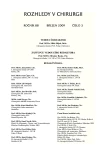The Effect of Preoperative Administration of Heparin on the Heparin Resistance Development
Authors:
V. Brzek 1; V. Lonský 2; S. Jiška 3; J. Kubíček 1; D. Nováková 1; P. Valentová 1; J. Bímová 1; M. Volt 1
Authors‘ workplace:
Kardiochirurgická klinika FN a LF UK Hradec Králové, přednosta: doc. MUDr. Jan Harrer, CSc.
1; Kardiochirurgická klinika FN UP Olomouc, přednosta: doc. MUDr. Vladimír Lonský, Ph. D.
2; Chirurgická klinika FN a LF UK Hradec Králové, přednosta: doc. MUDr. Alexander Ferko, CSc.
3
Published in:
Rozhl. Chir., 2009, roč. 88, č. 3, s. 103-105.
Category:
Monothematic special - Original
Overview
Background:
Heparin resistance is relatively frequent problem in cardio surgery. We were try to determine real occurrence heparin resistance before operation.
Aim of the study:
Purpose of the project – to find the real frequency of heparin resistance in patients who will undergo a cardio surgical operation. To find out the dependence between the pre-operational application of heparin and the development of heparin resistance.
Methods:
We recorded pre-operative administration heparin in patients. If the dose of heparin was 5 mg/kg and more then we insert patients to the group heparin resistant.
Results:
In our collection was heparin resistance in 203 patients from 624, it was 32,5%. Test agreement relative frequency with 22% was throw out – p < 0.001 – heparin resistance in our group statistically different from 22% – heparin resistance was higher than hypothesis. Heparin before operation was administrate 181 patients, which make to 29%. For administration of heparin was hypothesis of independence thrown (p < 0.001).
Conclusion:
Results of our works confirmed statistically significant occurrence of heparin resistance in patients that was administration heparin pre-operative. Heparin resistance occurred against presumption 22% in 32.5% in our group. It is statistic significant difference.
Key words:
heparin resistance – activated clotting time – heparin – extracorporela circulation
Sources
1. Lonský, V. Mimotělní oběh v klinické praxi. Praha, Grada Publishing, a.s., 2004.
2. Cloyd, G. D’Ambra, M., Akins, C. Diminished anticoagulant response to heparin in patients undergoing coronary artery bypass grafting. I Thorac. Cardiovasc. Surg., 1994, 57, 1211–1216.
3. Staples, M., Dunton, R., Karlson, K., et al. Heparin resistance after preoperative heparin therapy. on intraaortic balloon pumping. Ann. Thorac. Surg., 1994, 57, 1211–1216.
4. Chlumský, J., a kol. Antikoagulační léčba. Praha, Grada Publishing, a.s., 2005.
5. Kubisz, P., a kol. Hematológia a transfuziológia, Praha, Grada Publishing, a.s., 2006.
6. Ganter, M. T., Monn, A., Tavakoli, R., et al. Monitoring activated clotting time for combined heparin and aprotinin application in vivo evaluation of a new aprotinin-sensitive test using Sonoclot. European Journal of Cardio-Thoracic Surgery, 2006, vol. 30, 278–284.
7. Isgró, G., Cazzaniga, A., Soro, G., et al. Predictors for heparin resistance in patients undergoing coronary artery bypass grafting. Perfusion, 1999, Vol. 14, No. 6, 437–442.
Labels
Surgery Orthopaedics Trauma surgeryArticle was published in
Perspectives in Surgery

2009 Issue 3
- Metamizole vs. Tramadol in Postoperative Analgesia
- Metamizole at a Glance and in Practice – Effective Non-Opioid Analgesic for All Ages
- Obstacle Called Vasospasm: Which Solution Is Most Effective in Microsurgery and How to Pharmacologically Assist It?
Most read in this issue
- Position Variability of the Vermiform Appendix and Effect on Diagnosis of Appendicitis in Children
- Limitations of Liver Resections
- Bouveret‘s Syndrome – A Rare Case of Proximal Ileus of Biliary Etiology
- Giant Solitary Fibrous Tumor of the Pleura – Case Report
